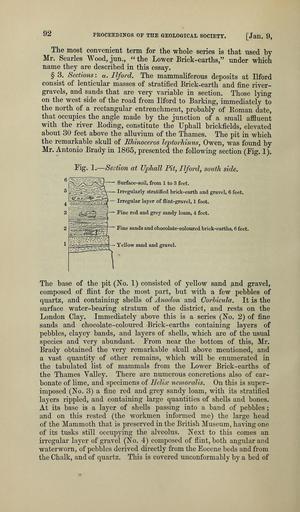MAKE A MEME
View Large Image

| View Original: | The_Quarterly_journal_of_the_Geological_Society_of_London_(13071052423).jpg (1211x2069) | |||
| Download: | Original | Medium | Small | Thumb |
| Courtesy of: | commons.wikimedia.org | More Like This | ||
| Keywords: The Quarterly journal of the Geological Society of London (13071052423).jpg 92 PHOCEteDINGS OF THE GEOLOGICAL SOCIETY Jan 9 <br> The most convenient term for the whole series is that used by <br> Mr Searles Wood jun the Lower Brick-earths under which <br> name they are described in this essay <br> §3 Sections a Ilford The mammaliferous deposits at Ilford <br> consist of lenticular masses of stratified Brick-earth and fine river- <br> gravels and sands that are very variable in section Those lying <br> on the west side of the road from Ilford to Barking immediately to <br> the north of a rectangular entrenchment probably of Eoman date <br> that occupies the angle made by the junction of a small affluent <br> with the river Eoding constitute the Uphall brickfields elevated <br> about 30 feet above the alluvium of the Thames The pit in which <br> the remarkable skull of Rhinoceros leptoi-Mnus Owen was found by <br> Mr Antonio Brady in 1865 presented the following section Pig 1 <br> I'ig 1 ” Section at Uphall Pit Ilford south side <br> ” Surface-soil from 1 to 3 feet <br> ” Irregularly stratified brick-earth and gravel 6 feet <br> Irregular layer of flint-gravel 1 foot <br> ” Fine red and grey sandy loam 4 feet <br> Fine sands and chocolate-coloured brick-earths 6 feet <br> Yellow sand and gravel <br> The base of the pit No 1 consisted of yellow sand and gravel <br> composed of flint for the most part but with a few pebbles of <br> quartz and containing shells of Anodon and Corhicida It is the <br> surface water-bearing stratum of the district and rests on the <br> London Clay Immediately above this is a series N'o 2 of fine <br> sands and chocolate -coloured Brick-earths containing layers of <br> pebbles clayey bands and layers of shells which are of the usual <br> species and very abundant Prom near the bottom of this Mr <br> Brady obtained the very remarkable skull above mentioned and <br> a vast quantity of other remains which will be enumerated in <br> the tabulated list of mammals from the Lower Brick-earths of <br> the Thames Valley There are numerous concretions also of car- <br> bonate of lime and specimens of Helix nemoimlis On this is super- <br> imposed No 3 a fine red and grey sandy loam with its stratified <br> layers rippled and containing large quantities of shells and bones <br> At its base is a layer of shells passing into a band of pebbles ; <br> and on this rested the workmen informed me the large head <br> of the Mammoth that is preserved in the British Museum having one <br> of its tusks still occupying the alveolus Next to this comes an <br> irregular layer of gravel No 4 composed of flint both angular and <br> waterworn of pebbles derived directly from the Eocene beds and from <br> the Chalk and of quartz This is covered unconformably by a bed of 36344819 112028 51125 Page 92 Text v 23 http //www biodiversitylibrary org/page/36344819 1867 Geological Society of London NameFound Anodon NameConfirmed Anodon EOLID 4752261 NameBankID 112384 Biodiversity Heritage Library The Quarterly journal of the Geological Society of London v 23 1867 Geology Periodicals Smithsonian Libraries bhl page 36344819 dc identifier http //biodiversitylibrary org/page/36344819 smithsonian libraries Information field Flickr posted date ISOdate 2014-03-10 Check categories 2015 August 26 CC-BY-2 0 BioDivLibrary https //flickr com/photos/61021753 N02/13071052423 2015-08-26 14 54 44 cc-by-2 0 PD-old-70-1923 The Quarterly journal of the Geological Society of London 1867 The Quarterly journal of the Geological Society of London 1867 Photos uploaded from Flickr by Fæ using a script | ||||